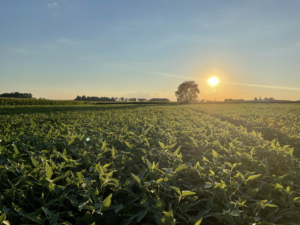I have seen your future and it looks amazing.
The funny thing about the aging process: The more of the past you have experienced, the more you of the future you can accurately predict. You know, like when you watch your son jump in the car to back out of a parking spot, notice the vehicle to his right is in danger of being swiped when he absolutely is going to swing the front end that direction, start running to tell him not to scrape up that neighboring car and get there a second too late as he commits the deed. You don’t know that? I do. I’ve seen it all take place just moments before it really did.
All over the Midwest, farmers have begun the 2022 soybean harvest. Early maturing and early planted fields have changed color and dropped leaves, and in fact, combines are rolling now in many regions. We are ready to read our report card on how we did this growing season. Want to envision a higher score for yourself? Here are three actions I see you taking that will brighten your future.
- You will harvest in segments. The hours of the day, the portions of the field – these will be partitioned for optimal harvest moisture. The difference between soybeans entering the bin at 13% moisture versus, say, 10% is a loss of 3.3% of total yield (Zoubek & Burr, UNL Extension). For a crop that would be 72bpa at 13%, you lose almost $32 per acre at that 10% moisture level, considering beans priced at $14.50. That changes your perspective on continuing to roll through that field late into a sunny day. Switch over to corn for the rest of the day (if possible) and let nature rehydrate your crop overnight for the next morning’s run
- You will address late season insect pressure. I was in Ogle County, IL recently and the little green Northern Corn Root Worm beetles swarmed like you would normally expect from hordes of gnats. Even now, but particularly after corn starts leaving the fields, those pesky critters flood into soybean acres and start menacing pods. They are not the only harmful pests you need to be wary of, but I mention them as an example. If the combine has not yet extracted the crop from your farmland, then your work is not done when it comes to scouting and protecting.
- You will pay more attention to genetics when it comes to selecting seed purchases than ever before. Selecting on price… that’s one thing. Selecting for herbicide trait packages, that’s also quite important. However, after taking the hit on overwhelming disease pressure and weather events yet again this year, you will study, discuss, plan and purchase according to the integrity of the base genetics in the varieties you select. In my portion of Illinois and way beyond, a double whammy of Sclerotinia White Mold and Sudden Death Syndrome has been devastating. When you move into the drier region, Brown Stem Rot becomes the lead culprit with Crown Rot in the mix as well. When talking to your seed supplier, shift your mental processes away from “what was your best variety last year?” to “here is what I need to be successful on the (insert pet name for your acreage of note here…like The Sahara, The What Was I Thinking, The Barn Burner, or the hundreds of other unique designations farmers give to their properties) farm.”
Like everyone else in this industry, I love hearing from a happy customer. While the weather may be responsible for setting an average for productivity in your region, it is true that there will be those who are above average and those who are below.
You have the tools available to be above average. I have foreseen it.



 and then
and then